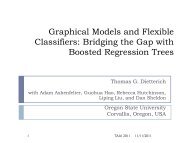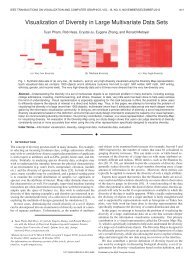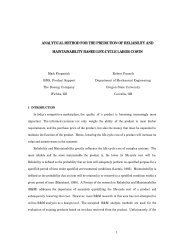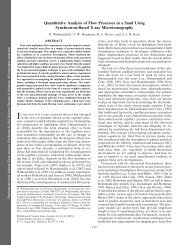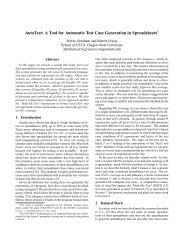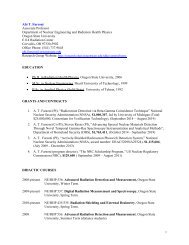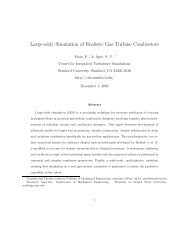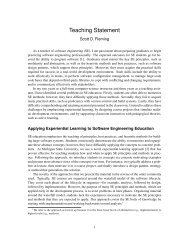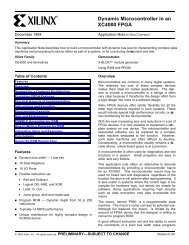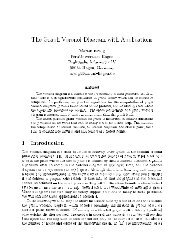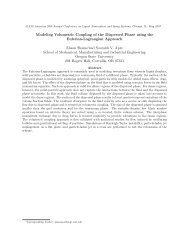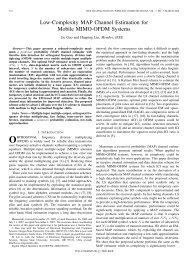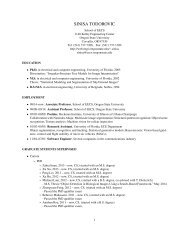DNS of Low Reynolds Number Flow Dynamics of a Thin Airfoil with ...
DNS of Low Reynolds Number Flow Dynamics of a Thin Airfoil with ...
DNS of Low Reynolds Number Flow Dynamics of a Thin Airfoil with ...
- No tags were found...
Create successful ePaper yourself
Turn your PDF publications into a flip-book with our unique Google optimized e-Paper software.
1 Introduction and ObjectivesThe desire to advance the use <strong>of</strong> thin, low Re wings at small scales introduces flow dynamics that significantlyinfluence their performance and flow control. At sufficiently high angles <strong>of</strong> attack during transients, flowover an airfoil separates, which can lead to a ‘dynamic stall’ condition. One major concern <strong>of</strong> thin airfoildesign, when operating at high lift conditions, is the unsteady nature <strong>of</strong> separation at the leading edgeresulting in a Kelvin-Helmhotlz type flow instability [1, 2, 3]. This causes the generation and convection <strong>of</strong>low frequency large vortical structures that have a strong influence on unsteady lift. Very early works onflow over hydr<strong>of</strong>oils and wings [4, 5] have shown a strong correlation <strong>of</strong> pressure in the separation bubble<strong>with</strong> the onset <strong>of</strong> stall conditions.For very low <strong>Reynolds</strong> number [O(100)], the unsteady flow characteristics <strong>of</strong> thin wings undergoingplunge maneuvers show downstream advection <strong>of</strong> the leading edge vortex and the frequency for unsteadylift characteristics [6]. Other studies <strong>of</strong> unsteady flow characteristics during pitching include [7, 8, 9, 10]and recent computational work based on immersed boundary technique under the AFOSR MURI programat CalTech on impulsively started wing [11, 12, 13]. It is clear from these and other studies that vortexshedding, advection, and strength is highly dependent on the maneuvering characteristics.Extensive studies at low Re have been carried out to better understand the flow and its dynamic characteristicsfor stability and control considerations. At low Re, thin flat airfoils actually delay stall to higherangles <strong>of</strong> attack when operating at lower aspect ratios, although the lift is somewhat lower at lower angles <strong>of</strong>attack [14]. It has been shown that a cambered plate (4%) performs better in the Re range <strong>of</strong> 10 4 –10 5 [14],and has a low sensitivity to the trailing edge geometry and the turbulence intensities [15]. Although thinairfoils show many advantages at low Re, such as high lift-to-drag ratio, they exhibit wide fluctuations inlift mainly caused by the unsteady flow separation at the leading edge ([16] and references therein). Thecharacter <strong>of</strong> this separation is highly unsteady, at fairly low frequencies, and generally <strong>with</strong>out reattachmentif the angle <strong>of</strong> attack is sufficiently large [16], however, most <strong>of</strong> this work is at somewhat higher Re(∼ 3 × 10 5 ). As the angle <strong>of</strong> attack is increased to the stall condition there is a rise in the unsteady character<strong>of</strong> the lift coefficient, <strong>with</strong> rms fluctuations on the order <strong>of</strong> 0.1–0.2. This is in contrast to the unsteadylift coefficients which are on the order <strong>of</strong> 0.03 for trailing edge stall. The thin airfoil stall versus angle <strong>of</strong>attack is associated <strong>with</strong> a drop in lift coefficient, a rise in unsteadiness and then a subsequent rise in lift,and it is asserted that the unsteadiness in lift is a direct consequence <strong>of</strong> the leading edge separation [16].Effect <strong>of</strong> impressed acoustic excitation <strong>of</strong> the airfoil as a method <strong>of</strong> flow control [17] has been investigatedto reduce the unsteadiness in flow separation and lift oscillations. Vorticity mapping, to quantify unsteadyflow associated <strong>with</strong> airfoil motion, has been used to correlate thrust <strong>with</strong> shedding frequency [18].1



